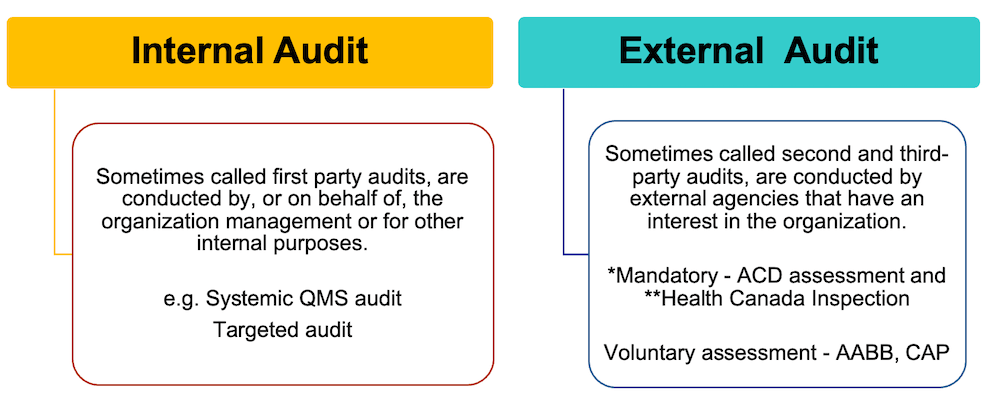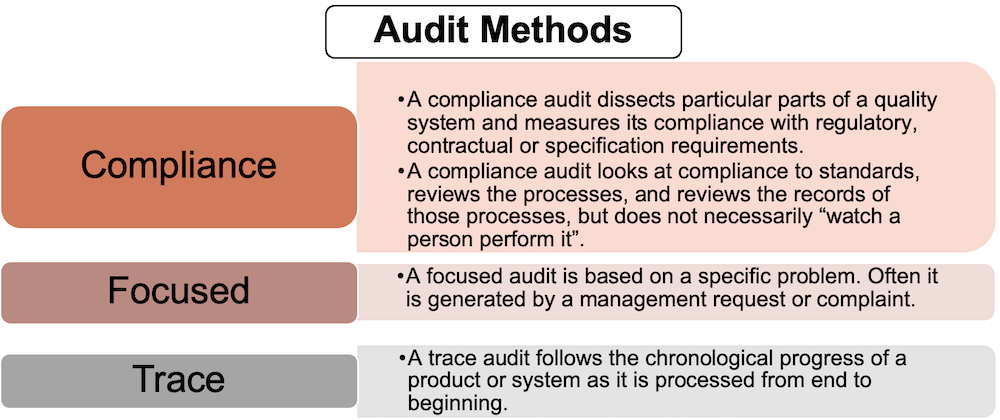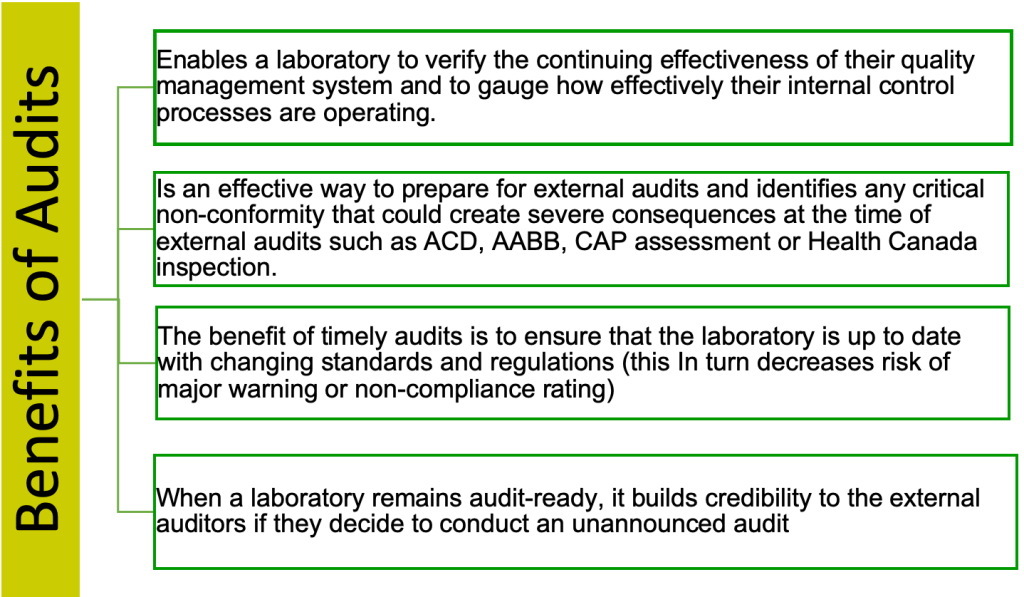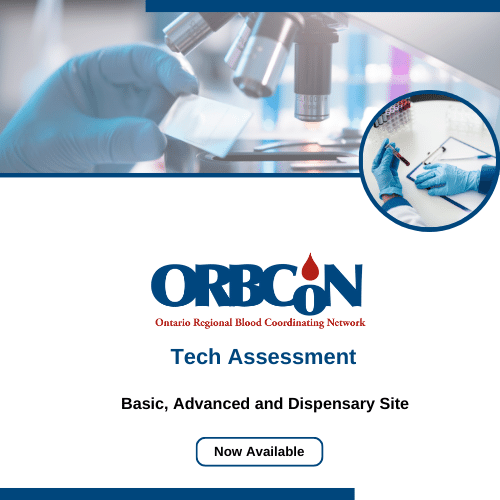Why are audits important and beneficial for laboratory?
Sneha Patel, BMLSc, MLT, CTBS
Quality Assurance & Safety Officer
Transfusion Medicine and Tissue Bank
Sunnybrook Health Sciences Centre
An audit is a systematic, independent, objective and documented process for gathering information. An audit provides opportunities for improvement and identifies areas of risk in systems and processes. Within an organization, it measures the strengths and weaknesses against the organization’s own procedures, voluntary external standards, and required regulations such as Accreditation Canada Diagnostics and Health Canada’s Blood Regulations. Audits should be integrated into the laboratory’s Quality Management System (QMS).
There are various types and methods of audits applicable to laboratories:

*Accreditation Canada Diagnostics (ACD) – formerly known as IQMH is mandatory in Ontario. ACD has expanded assessments to some provinces within Canada (e.g. Province of Ontario, Province of New Brunswick, and Province of Newfoundland & Labrador)
**Health Canada inspection applies to the Blood Bank/Transfusion Medicine laboratories that fall under Health Canada Blood Regulations.

The audit type and method of audit that fits a laboratory model can be determined based on the scope of the laboratory services, accreditation and licence(s). Laboratories that undergo ACD accreditation are required to conduct an internal audit annually of their Quality Management System. In addition to the ACD accreditation, many laboratories that have a Blood Bank may also have additional regulatory requirements under Health Canada Blood Regulations which requires Blood Bank to conduct internal audits every two years at minimum on all regulated activities as defined by the Blood Regulations. Some laboratories may hold accreditation from other voluntary organizations such as the Association for the Advancement of Blood & Biotherapies (AABB) and the College of American Pathologists (CAP) which may have their own audit requirements. Most laboratories participate in internal and external audits. It is highly beneficial for a laboratory to conduct their own internal audits periodically to identify areas of improvement and compliance with standards and regulations.

An audit can be performed by trained personnel, or by an external auditor (qualified third party) who is performing the audit on behalf of the establishment and is knowledgeable in the subject matter being audited. An auditor should not audit their own area of work in-order to mitigate any bias or conflict of interest. Especially if an audit is being conducted on regulated activities that falls under Health Canada Blood Regulations, the auditor must not have direct responsibility for the procedures or processes they are auditing. For example, a supervisor responsible for component preparation must not audit any component preparation activities conducted by their own department. An auditor should always use an evidence-based approach when auditing, based on objective evidence and first hand observation(s).
The success of the internal audit is based on adequate preparation, precise performance, well documented and insightful reporting, and productive follow-up post internal audit completion. There are various audit tools and resources available in how to conduct audit. Refer to the list of available resources for further information included at the end of this article.
Internal audits can be performed on any laboratory operational activities. Below are some examples of application of internal audits. Audits can be tailored to meet laboratory requirements.
Laboratory Equipment – an internal audit can be performed to determine if the laboratory procedures established for equipment maintenances are conformant e.g., preventative maintenance (PM) are being performed as per scheduled, by or before it reaches its due date, repairs and post repair equipment verification procedures are being followed by laboratory, service and maintenance reports are reviewed and signed off by the designated quality or management personnel etc. The purpose of the audit is to verify if there are any gaps identified in meeting equipment PM services, and to ensure conformance to the laboratory equipment procedures.
Blood Components and Blood Products – an internal audit will verify whether the Blood Bank is following their procedures in respect to the review, screening of incoming blood component or blood product request from physician for appropriateness, preparation and issuing procedures are conformant to the established laboratory and institution policy on blood components and blood product utilization.
Staff Training and Competency Program – an internal audit will verify whether the training and competency program is sufficient in meeting the applicable laboratory standards and regulations. Are training and competency documents being completed as per the established laboratory procedures? Training and competency are challenging areas where completion of certain training tasks is dependent on other factors which often leads to incomplete documentation. Hence, periodic internal audit especially on newly recruited staff training and competency records is highly beneficial to help identify any gaps and allows laboratory to act in a timely manner prior to the external assessments or inspections.
Some of the key points to consider when conducting an audit is to ensure that the audit is followed through from start to the end. Post audit, it is crucial that a laboratory prepares a final summary of identified gaps and reviews them with all key stakeholders including senior management. Have a corrective action plan identified with responsible individuals or team members along with a time-line for completion. Over time, it becomes challenging to go back to the audit gaps as there might be numerous audits on the go. However, it is imperative that a follow-up closure is done to ensure all identified gaps from each audit have been completed timely. Senior Management support is vital to the effectiveness and success of the audit program. Audit data gathered can provide management information for future planning, determining risk, and for understanding the effectiveness of laboratory operation. In summary, having a robust internal audit program proves to be highly beneficial in identifying gaps and provides an opportunity for improvements and ensures that a laboratory is in a ready state for any up-coming external laboratory assessment or inspection.
Relevant Information:
- Guidance Document: Blood Regulations, 2014-10-22, 94(1)(j)Internal Audit System; https://www.canada.ca/en/health-canada/services/drugs-health-products/biologics-radiopharmaceuticals-genetic-therapies/applications-submissions/guidance-documents/blood-regulations/guidance-document-blood-regulations.html
- Clinical and Laboratory Standards Institute guideline QMS15—Laboratory Internal Audit Program, QMS15-Ed2 May 2022 – https://clsi.org/media/2jofh5wr/qms15_sample.pdf
Clinical and Laboratory Standards Institute guideline QMS15—Laboratory Internal Audit Program provides recommendations for establishing an internal audit program and related processes for enhanced quality and continual improvement in the laboratory. The audit program defines the “who,” “what,” “when,” “where,” and “how” of meeting requirements for internal auditing, and the audit process describes the details of conducting an audit. Committed laboratory leadership and individuals willing to share their expertise and experience enable a successful internal audit program. Clinical and Laboratory Standards Institute (CLSI). Laboratory Internal Audit Program. 2nd ed. CLSI guideline QMS15 (ISBN 978-1-68440-150-5 [Print]; ISBN 978-1-68440-151-2 [Electronic]). Clinical and Laboratory Standards Institute, USA, 2022. - Laboratory Audits: Overview, Guide, and Tips by Germans Frolovs | Feb 25, 2022 | Audits; SimplerQMS Company; https://www.simplerqms.com/laboratory-audits/
- Laboratory Internal Audit Plan, Association of Public Health Laboratories, 2017; https://www.aphl.org/aboutAPHL/publications/Documents/QS-2017May-Internal-Audit-Plan.pdf
From ORBCoN Crew
TM New Year’s Resolution
A New Year is upon us and with the New Year comes time for new beginnings. New beginnings bring to mind resolutions and TM departments are always striving to improve their services which is what resolutions are all about!
ORBCoN would like to suggest some New Year’s resolutions for your TM department. These are based on the top Accreditation Canada Diagnostic non-conformances that were noticed from the previous year
This year Transfusion Medicine resolves to:
WANT: Have a training program and competency assessment process that is evaluated for its effectiveness for all personnel involved in the administration of blood products including physicians, nurses, and laboratory personnel, that will consider the complexity of tasks and potential for error.
NEED: Equipment that have the capacity to monitor the temperature range of the contents, can be set at the acceptable temperature range for the products stored inside and have an audible alarm when temperatures go beyond the acceptable range.
SHARE: Procedures for the return of products from a clinical area that take into consideration all possible products that can be issued, not only red blood cell units.
SUCCEED: Establish a comprehensive home infusion process that includes all necessary elements such as identification of person picking-up the product, redistribution of products near expiry, safety precautions, sources of variability, and follow up for transfusion complications.
Newsboard
Tech Assessment

The Bloody Easy Technologist Assessment program is now available on the new ORBCoN Learning Management System (LMS) and Surge Learning platforms.
A communication has been issued with instructions to provide site administrator information for access to the ORBCoN LMS and guidance for current Surge Learning clients.
If you have any questions or have not received the communication please reach out to alison.wendt@sunnybrook.ca
New! Save the Dates
Transfusionists Talk: Transfusion Made Bloody Easy

More info to follow! To submit a topic or patient case, email: bertad@mcmaster.ca
Featured Resources
Bloody Easy 5

Patient Pamphlet: New Version

Upcoming Events
UofT TM Rounds

January 26, 2023 @12pm-1pm
Marginalized communities in trauma research by Dr. Barbara Haas